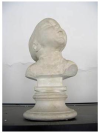edited by Johannes Grave 01:00 - Sunday, 22. April 2007
Classical forms and classic epistême
As an institution that defines itself by regimes of structures, orders, systems and comprehensible displays, the museum often shows similarities to characteristic features of classical art. Some older arrangements and settings of the Copenhagen Medical Museion refer obviously to traditional, 'classical' modes of presentation: Long series of symmetrically arranged, technical instruments resemble exhibitions of coins, gems and other precious objects in art collections. A wax model, which discloses the inner structure of the female body, is framed by wooden profiles and reminds of conventional iconographic formulas (e.g., the death of Lucretia). A partially mummified head with coloured venes and muscles is mounted on a classical plinth, which traditionally is used for busts of gods, heroes or famous men.
In the gynaecological section of the Museion, the use of classical plinths gains a critical quality. Two vitrines show an astonishing rich collection of conserved embryos and foetuses that are characterized by different deformities. These vitrines are 'crowned' by five little plaster models of malformed embryonic heads, which were manufactured by the 'Medizinisches Warenhaus Berlin'. By their origin from a department store, their classical formed plinths and their place on the top of the showcases, these plaster models represent a strange, but by no means unique combination of medicine, economy and popularized classical design.
Especially one plaster bust attracts our attention because of its posture of the head, which shows a striking similarity to classical sculptural representations of suffering mythological heroes, e.g., Laocoon or the sons and daughters of Niobe. In the late 18th century these works were in the centre of heated debates on the representation of emotions and pathos in works of art (J. J. Winckelmann, A. Hirt, J. W. Goethe). Laocoon and the Niobid group - sculptures, which were well known, because they were often reproduced as plaster models, - can be understood as exemplary works of art that serve to subdue and domesticate human emotions and sensations. The plaster bust of the malformed embryonic head not only resembles - to some extent - these works of classical ancient art, but it seems to aim at a similar project of domestication. It makes the malformed human head appear more familiar and allows putting it in a pre-ordered structure by mounting it on a plinth. Perhaps these parallels between classical sculptures and plaster models of deformities can be understood as an indication of an epistemological convergence between classical forms and the classic epistime that tends to an ideal of a totally transparent representation. But, on the other hand, it is this contextualisation of the malformed head by means of classical forms that bastardises their intrinsically pure style

